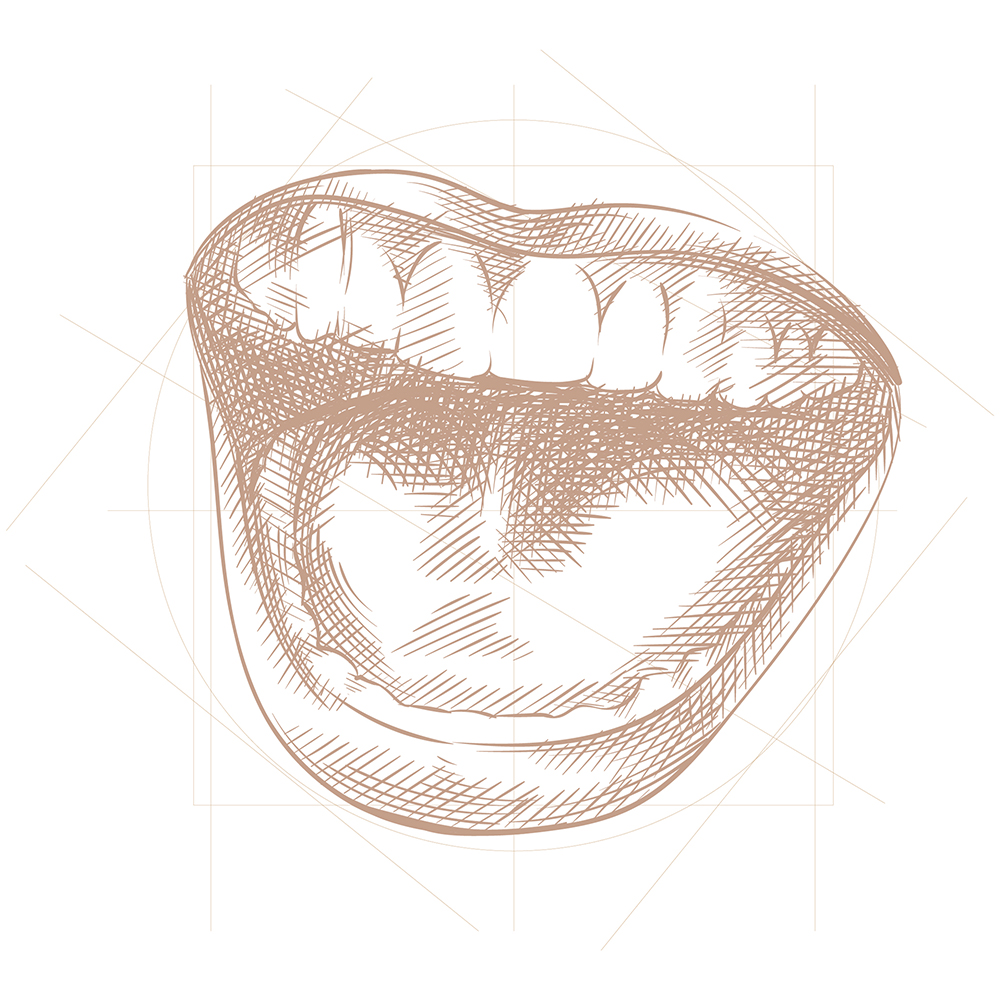Bonding Application
Bonding is a practical and aesthetic dentistry method used to correct minor defects in teeth. It is an ideal option to solve problems such as fractures, cracks, gaps between teeth, discolouration or deformities. This procedure uses composite resin material that adapts to the natural tooth colour. Bonding has become a popular aesthetic solution today, as it can be applied both quickly and without damaging the natural structure of the tooth.
Bonding Application Steps
Bonding is carried out in a careful and systematic process. Here is how it happens step by step:
- Initiation and Preparation
Bonding is often performed without abrading the tooth surface, making it a minimally invasive option. Usually no anaesthesia is required, but local anaesthesia may be preferred for patient comfort. The tooth is cleaned and made suitable before the procedure. - Surface Preparation
In order for the composite material to adhere to the tooth, the tooth surface is slightly roughened with a special gel. The acid-based solution used at this stage strengthens the adhesion by opening microscopic pores in the tooth enamel. - Adhesive Application
An adhesive (bonding agent) is applied to the tooth to ensure the connection with the composite resin. This layer ensures that the material is firmly attached to the tooth and is one of the cornerstones of the process. - Shaping the Resin
The composite resin selected according to the patient’s tooth colour is applied to the tooth layer by layer. This material, which has not yet hardened, is brought to the desired shape by the dentist. Fine adjustments are made according to the natural structure of the tooth and the patient’s expectations. - Hardening Process
When the forming is finished, the resin is hardened with a special light source. This blue light ensures that the material solidifies and is fixed to the tooth within seconds. - Finishing Touches
The hardened material is levelled and polished on the tooth surface. This step gives the tooth a smooth, shiny and natural appearance. The bonded tooth becomes compatible with other teeth.
Benefits of Bonding
Bonding is characterised by its practicality and aesthetic results. Here are the main advantages of this method:
- Results in a Short Time: Most bonding procedures are completed in a single session; there is no need for long treatment processes.
- Natural Tooth Protection: Since minimal work is performed on the tooth surface, healthy tooth tissue is not damaged.
- Eye-Catching Aesthetics: The material used matches the natural colour of the tooth and does not look artificial.
- Reasonable Cost: It is more economical than alternatives such as porcelain coating.
- Comfortable Experience: It is generally painless and offers a comfortable process for patients.
In Which Cases Is Bonding Preferred?
Bonding is suitable for people with small-scale aesthetic problems. For example:
- Those with small fractures or cracks in their teeth,
- Those who want to close the gaps between the teeth,
- Those who want to correct slight discolouration,
- Those who want to slightly improve their tooth shape or size.
However, bonding may be insufficient for major damage or advanced colour problems. In this case, it will be useful to evaluate alternatives with your dentist.
Lifespan and Maintenance of Bonding
In order for bonding to last for a long time, it is necessary to pay attention to some habits:
- Stain Prevention: In the first few days, avoid substances such as coffee, tea or cigarettes that can leave a colour.
- Tooth Protection: Avoid biting hard objects or biting your nails.
- Hygene: Brush your teeth regularly and do not neglect flossing.
- Control Visits: Have your dentist check the condition of your bonding once a year.
With proper care, bonding can maintain its aesthetic appearance for 5 to 10 years. The way you use it and the importance you attach to your oral health can affect this period.
Is Bonding Suitable For You?
Bonding is a great option for those looking for a quick and natural solution in dental aesthetics. If you want to make a big difference to your teeth with minimal intervention, this method may be for you. You can evaluate the suitability of bonding for your needs and other possible options by contacting your dentist. Achieving an aesthetic smile may be easier than you think!
Lifespan 3 to 10 years.
Is it necessary to renew it? Yes, they may wear, discolour or crack over time. In this case, renovation or repair is required.
To prolong its life:
-
Avoid breaking hard foods (such as ice, nuts, biting a pencil) with the teeth.
-
Prevent discolouration by reducing coffee, tea and cigarette consumption.
-
Have regular dental cleanings and check-ups.
Where Can Dental Bonding Be Applied?
- Front Teeth: Most commonly applied to front teeth for aesthetic concerns. Color irregularities, small chips, and gaps can be closed.
- Premolars (Small Molars): Can be used for minor wear or small corrections.
- Tooth Gaps (Diastema Closure): An effective method for filling small spaces between teeth.
Where Is Dental Bonding Not Suitable?
- Back Molars (Grinding Teeth): Bonding can easily wear down or break on back teeth where chewing pressure is high. Therefore, porcelain crowns or fillings are generally preferred.
- Large Structural Damage: If a large portion of a tooth is missing, bonding may not be durable enough. In such cases, crowns or porcelain veneers might be a better solution.
Conclusion:
Bonding is ideal, especially for front teeth, but it may not be long-lasting in areas subjected to excessive chewing force. If significant corrections are needed on back teeth, more durable alternatives should be considered.
Yes, when applied correctly, the bonding procedure looks quite natural. However, the quality of the material used, the dentist’s experience, and the correct adjustment of the tooth color are very important for this.
Factors Ensuring Natural Appearance of Bonding:
Use of Composite Matching Tooth Color:
If your dentist chooses the composite resin that best matches the natural color of your teeth, the bonding will blend with the surrounding teeth and go unnoticed.
Correct Shaping and Smoothness:
If the bonding material is shaped to match the natural structure of the tooth, the tooth’s natural curves and luster are preserved.
Surface Polishing:
After the procedure, the bonding area is polished to become shiny and smooth like natural tooth enamel.
Light Translucency:
High-quality composite materials transmit light like natural teeth, so they do not appear dull or artificial.
What is Dental Bonding?
Bonding is an aesthetic dental procedure used to correct minor imperfections in teeth. It involves applying a special composite resin (a tooth-colored filling material) to the tooth surface to improve its shape, size, or color. It’s a quick, painless procedure that doesn’t harm the natural tooth structure.
How is Dental Bonding Performed?
A bonding procedure typically takes 30-60 minutes and involves the following steps:
-
Examination and Planning
Your dentist will assess your tooth’s condition and determine which areas need bonding. They’ll also select the correct shade to ensure the bonding blends seamlessly with your natural teeth.
-
Tooth Preparation
Anesthesia is usually not required unless there’s decay or a fracture in the tooth, in which case a local anesthetic may be used. The tooth surface is gently roughened to allow the bonding material to adhere better. A bonding gel is then applied to prepare the tooth for the composite material.
-
Composite Resin Application
The selected tooth-colored composite material is applied to the tooth in layers. It’s carefully shaped to match the tooth’s natural structure.
-
Curing with a Special Light
The applied composite is hardened using a blue LED light (UV light). This process integrates the bonding material with the tooth, making it durable.
-
Shaping and Polishing
Finally, your dentist will make any necessary final adjustments, remove excess material, and shape the tooth to fit its natural contours. The surface is then polished to achieve a smooth, glossy appearance.
The bonding procedure typically takes between 30 and 60 minutes to complete. However, this duration can vary depending on the number of teeth to be treated and the size of the imperfection to be corrected.
- For a single tooth: 30-60 minutes
- For multiple teeth: 1-2 hours
- For a full aesthetic transformation (6-8 front teeth): 1-2 sessions may be required
How Many Sessions Are Needed?
- Most of the time, a single session is sufficient.
- If bonding is applied to multiple teeth, it may take 1-2 sessions, depending on the number of teeth.
- Additional sessions may be planned for extensive aesthetic changes or if existing bonding needs to be renewed.
Who Can Get Bonding Treatment?
Bonding is suitable for most people who want to correct minor aesthetic imperfections in their teeth. Individuals experiencing the following conditions can get bonding:
- Those with gaps between their teeth (diastema closure)
- Those with small chips or cracks in their teeth
- Those unhappy with the color of their teeth (to cover stains)
- Those who want to correct the shape or size of their teeth
- Those with enamel wear
- Those who want to correct minor misalignments without the need for orthodontic treatment
In Which Cases Is Bonding Preferred?
Bonding is preferred as a practical and economical solution in the following situations:
- If a quick aesthetic solution is desired – It can be completed in a single session.
- If an alternative to more costly treatments is sought – It is more affordable compared to porcelain veneers.
- If minimal intervention to the tooth surface is desired – No damage is done to the tooth enamel, or very little is abraded.
- If comprehensive treatment is not required – It is ideal for minor aesthetic corrections.
Who Is Not Suitable for Bonding?
- Those with very large structural losses – If the fracture is large, porcelain veneers or crowns are recommended instead of bonding.
- Those with teeth grinding (bruxism) problems – Bonding can wear down or break over time.
- Those with severe misalignments – If there are orthodontic problems too severe to be corrected with bonding, braces or clear aligner treatments may be more suitable.
There’s no specific age limit for bonding, but it’s generally recommended after tooth development is complete.
- It’s usually suitable for individuals 18 years and older.
- In children and adolescents (12-17 years), it can be done for tooth fractures or cosmetic reasons, but it might not be a permanent solution.
- For individuals whose tooth development isn’t complete (especially under 18), bonding may need to be renewed in later years as tooth size and structure can change.
After Bonding: What You Should Do
Regular Oral and Dental Care:
- Brush your teeth at least twice a day.
- Use dental floss to prevent plaque buildup.
- You can opt for fluoride toothpaste.
Regular Dental Check-ups:
- Visit your dentist every 6 months to check the condition of your bonding.
- Professional cleaning can extend the lifespan of your bonding.
Prevent Discoloration:
- Drinking dark-colored beverages like coffee, tea, and red wine with a straw can reduce staining.
- You can maintain the whiteness of your bonding with regular dental cleanings.
After Bonding: What to Avoid
Avoid Biting Hard Foods:
- Biting hard objects like ice, nuts, or pens can damage your bonding.
- Nail biting can cause your bonding to crack or break.
Avoid Habits That Cause Staining:
- Staining substances like coffee, tea, cigarettes, and wine can cause your bonding to yellow over time.
- If you consume them frequently, rinse your mouth or brush your teeth afterward.
Be Careful with Acidic and Sugary Foods:
- Carbonated drinks and overly sugary foods can harm your tooth enamel and the bonding surface.
Don’t Clench or Grind Your Teeth:
- If you have a habit of clenching or grinding your teeth, it’s recommended to use a night guard to prevent your bonding from breaking.
For bonding to last a long time, good oral hygiene, regular check-ups, and avoiding hard or staining foods are important. With proper care, bonding can last for 3-10 years!
No, when applied correctly, dental filling or bonding does not adversely affect your gums. The materials used are biocompatible and harmonise with the gums. However, if gum sensitivity occurs during filling or bonding, this is a temporary condition and returns to normal within a few days.
Yes, composite fillings and bonding usually last 5-10 years; this period depends on your oral hygiene, eating habits and how well you take care of your teeth. You can extend its life with regular tooth brushing and dentist check-ups. If wear or breakage occurs, it can be easily replaced.


